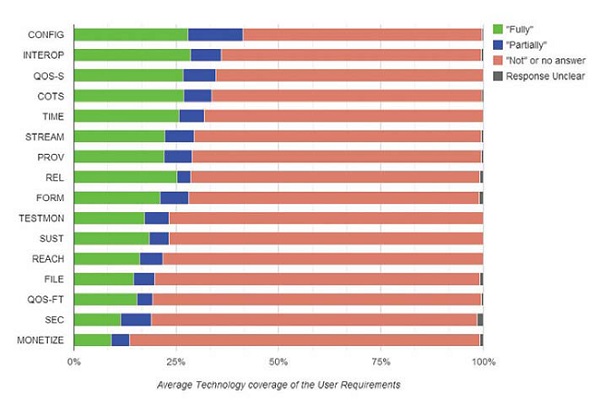Progress Towards the All-IT/Cloud Media Facility

Al Kovalick
The momentum of IT and cloud methods can’t be ignored.
Web-based distribution methods are largely cloud/IP-based today. Examples are Netflix, YouTube, Hulu, Watch ABC and many others. However, media facilities—some production, post-production, broadcast ops—still have strong components of AV-specific gear. Much of this infrastructure is not IT/cloud-friendly. Sure, file-based workflows are relatively mature, but real-time or live AV systems rely on the SDI streaming ecosystem for solutions.
In response, industry bodies are developing best practices and standards for interoperable methods for transporting in real-time and live; storing, converting and publishing media assets by leveraging IT methods. If these groups are successful, the world of custom AV devices and transport will dissolve into a world of IT/cloud services and solutions. The domains of AV-specific and IT/cloud will co-exist for many years so, bridging between them will become a way of life.
DIRECT VS. INDIRECT
The basic challenge is to replace SDI and AES3 audio streaming and associated ecosystems. SDI/AES3 have reigned as kings during the past 20 years because of their excellent lossless, low-latency QoS and frame-accurate switching.
There are fundamentally two different approaches for replacements: direct and indirect. The direct approach streams AV payloads over Ethernet using LAN Layer 2 (MAC addressing) and/or Layer 3 (IP addressing). The goal is to replicate the best features of SDI and its ecosystem (including point-to-multipoint routing), using Ethernet/ IP. SMPTE standard ST2022-6 maps SDI payload over IP and was conceived primarily for point- to-point trunking. It was not intended as a direct replacement for SDI but it comes close in some regards. Frame-accurate video switching using “off-the- shelf” Ethernet switches still poses the biggest challenge. Tests and demos have shown this is possible, but there are no media industry standards yet.

Fig. 1: Technology coverage against user requirements from JTF’s request for technology (chart courtesy of JTF sponsors).
The indirect approach does not attempt to duplicate SDI over Ethernet. Rather, the idea is to move sequential chunks of AV from a sender to receiver using TCP/IP or other reliable transport protocol. For example, it’s possible to move one frame, possibly lightly compressed, (or a few frames or even K lines) at a time between nodes. This method uses successive, continuous bulk transfers and nodal buffering to smooth out any network issues due to TCP jitter or latency. Think of this as a real-time quasi-file transfer between nodes. It’s not isochronous SDI streaming but it gets the job done.
The professional video industry's #1 source for news, trends and product and tech information. Sign up below.
Sending timed and chunked AV can maintain real-time transfer equivalence. The nodal buffering may add a full video frame of delay per node to keep the video in frame sync. In a large system, it’s easy to accumulate 0.5 to 1 second of end-to-end delay. While not a show stopper for many applications, this does complicate system design and “nodal sync” could become the next “lip sync” issue. One beauty of SDI and the direct approach is very low node-to-node delays of less than one line of HD video. On the other hand, the indirect method is cloud-friendly since it should operate fine over lossy, non-deterministic networks.
JOINT TASK FORCE ON NETWORKED MEDIA
The move to SDI/AES3 replacement won’t happen overnight but there is progress in this area. One major activity is the work of the Joint Task Force (JTF) on Networked Media. In 2013, this group was formed by The European Broadcasting Union, the Society of Motion Picture and Television Engineers and the Video Services Forum. This triumvirate provided personnel and resources to manage the work effort. A main focus is moving AV streaming transport to Ethernet, but the effort covers other themes too.
The JTF published an initial Call for Participation in April 2013. Next, they collected 136 uncorrelated business-driven user requirements from many responders which were boiled down to a correlated 16 “super user requirements” with 122 supporting points. In September the JTF issued a request for technology (RFT) to fulfill one or more of the user requirements. The JTF received 27 submissions with the respondents submitting a total of 66 different technologies applied to the user requirements. Finally, in December, the JTF published a Gap Analysis paper which summarizes the 27 submissions and accompanying technologies, organizing the information into charts and brief abstracts. See smpte.org/jt-nm for free access to the final report.
To no surprise, most of the submissions covered some, but not all, of the super user requirements. A few provided technology references to meet all of the 16 super user requirements. Fig. 1 lists the 16 main requirements (abbreviated, see report for details) on the vertical axis and the average requirements coverage from all 27 responders on the horizontal axis. For example, on average, the requirements for AV streaming (STREAM) were fully met by about 23 percent of the responders. This means that some submitted responses did not cover any of the aspects for the STREAM user requirements while others provided much more.
In general, the responses shed light on several relevant areas and a few technologies (out of the 66) have clear momentum. These include; IEEE 1588-V2 (PTP), SMPTE ST 2022-6, and IEEE 802.1 AVB. The three were mentioned more often than other technologies in the submissions.
This effort is a first for our industry. The report provides a respectable survey of what vendors and other industry bodies are thinking along the IT/cloud vein. Stay tuned to see what the JTF sponsors will do next now that the report has been published. It would be a shame to lose the momentum for this work. Many of the submitted technologies and similar input will be used to build the next generation of IT/cloud media infrastructure. This area is moving fast so don’t take your eye off the ball.
Al Kovalick is the founder of Media Systems consulting in Silicon Valley. He is the author of “Video Systems in an IT Environment (2nd ed).” He is a frequent speaker at industry events and a SMPTE Fellow. For a complete bio and contact information, visitwww.theAVITbook.com.

